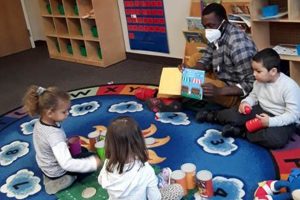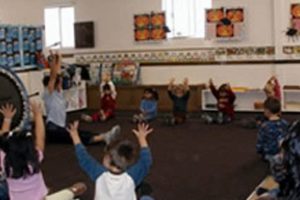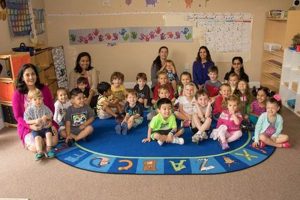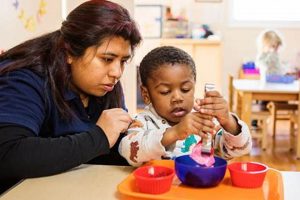Early childhood education offers diverse approaches to learning, with two prominent methods being the Montessori and traditional preschool models. A Montessori classroom emphasizes self-directed activity, hands-on learning, and collaborative play in a specifically prepared environment. Children choose their activities from a range of options designed to promote exploration and discovery. Traditional preschools, conversely, typically follow a more structured curriculum with teacher-directed activities, group lessons, and a focus on developing school-readiness skills through prescribed learning objectives.
The choice between these educational philosophies impacts a child’s learning experience significantly. Montessori education fosters independence, problem-solving skills, and a love for learning through self-discovery. It nurtures a child’s natural curiosity and encourages intrinsic motivation. Traditional programs often prioritize foundational academic skills, socialization within a structured setting, and preparation for the more formal environment of kindergarten. Both approaches aim to provide children with a strong foundation for future academic success, though their paths diverge in pedagogical methods and overall learning environment.
Understanding the core tenets of each approach is crucial for parents and educators. The following sections delve deeper into the specific differences between Montessori and traditional preschools, examining curriculum, teaching methodologies, classroom environments, and the potential impact on a child’s development. This exploration aims to provide a comprehensive overview to facilitate informed decision-making when selecting the most suitable early childhood education pathway.
Tips for Choosing Between Montessori and Traditional Preschools
Selecting the right preschool environment is a crucial decision for families. These tips provide guidance for navigating the choice between Montessori and traditional preschool programs.
Tip 1: Observe the Classroom Environment: Visiting potential preschools provides invaluable insights. Observing children engaged in activities within the classroom setting offers a firsthand understanding of the learning dynamics and overall atmosphere.
Tip 2: Consider the Child’s Learning Style: Some children thrive in self-directed environments, while others benefit from more structured guidance. Reflecting on a child’s personality, interests, and learning preferences is key.
Tip 3: Evaluate Curriculum and Teaching Methods: Examining the curriculum and pedagogical approach of each program clarifies educational priorities. This includes understanding the emphasis on academics, practical life skills, and social-emotional development.
Tip 4: Assess Teacher Qualifications and Interaction Styles: Qualified and engaged teachers are essential for a positive learning experience. Inquire about teacher training and observe their interactions with the children.
Tip 5: Explore the Emphasis on Independence and Socialization: Consider the balance between fostering independence and developing social skills. Montessori emphasizes self-reliance, while traditional programs may place more emphasis on group activities.
Tip 6: Compare School Readiness Philosophies: Understand how each program prepares children for kindergarten. Traditional preschools often focus on pre-academic skills, while Montessori emphasizes holistic development.
Tip 7: Factor in Practical Considerations: Location, cost, and scheduling logistics play a significant role in the decision-making process. Evaluate these practical aspects alongside educational philosophies.
By carefully considering these factors, parents can make informed decisions aligned with their child’s individual needs and developmental goals. Choosing the right preschool lays a strong foundation for future academic success and lifelong learning.
The following section concludes this exploration by summarizing the key distinctions and offering final recommendations for selecting the optimal preschool environment.
1. Learning Style
A child’s learning style significantly influences their success and engagement in different educational environments. Understanding the interplay between learning styles and preschool philosophiesMontessori and traditionalis crucial for selecting an appropriate early childhood education setting. This section explores how these two approaches cater to various learning preferences.
- Self-Directed Learning:
Montessori classrooms foster self-directed learning, allowing children to choose activities based on their interests and pace. This approach benefits children who thrive in autonomous environments and learn best through exploration and discovery. Traditional preschools, in contrast, often follow a more structured, teacher-directed approach, which may suit children who prefer clear guidance and established routines.
- Kinesthetic Learning:
Montessori education emphasizes hands-on, experiential learning with manipulative materials. This caters to kinesthetic learners who benefit from tactile engagement and physical interaction with learning concepts. Traditional preschools may incorporate hands-on activities, but often prioritize visual and auditory learning through group lessons and demonstrations.
- Visual and Auditory Learning:
While Montessori environments incorporate visual and auditory elements, they are typically integrated within the context of self-chosen activities. Traditional preschools often rely more heavily on visual aids, verbal instruction, and group learning, which can benefit children who learn effectively through observation and listening.
- Social Learning:
Both Montessori and traditional preschools offer opportunities for social interaction, but their approaches differ. Montessori classrooms encourage collaborative play and peer learning, fostering independence in social interactions. Traditional preschools often structure social interactions through group activities and teacher-led lessons, emphasizing cooperation and shared experiences.
Recognizing a child’s preferred learning style and understanding how each preschool approach aligns with these preferences aids in selecting an environment conducive to optimal growth and development. The ideal preschool setting provides a balance of structure and freedom, catering to individual learning needs while fostering a love for learning.
2. Teacher's Role
The teacher’s role differs significantly between Montessori and traditional preschool settings, impacting the overall learning experience. This distinction reflects the core philosophies of each approach, shaping the dynamics of the classroom and influencing how children engage with the learning process.
- Facilitator vs. Instructor:
In Montessori classrooms, teachers act as facilitators, guiding children’s exploration and discovery. They observe children’s interests, prepare the environment with appropriate materials, and offer individualized support. Traditional preschool teachers typically function as instructors, leading group activities, delivering lessons, and directing the learning process. A Montessori teacher might demonstrate how to use a specific material, then allow children to explore it independently, while a traditional preschool teacher might lead a group lesson on a particular topic.
- Observation and Guidance:
Montessori teachers emphasize observation, carefully monitoring children’s progress and adapting the environment to meet individual needs. They provide guidance and support when necessary, allowing children to develop problem-solving skills and independence. Traditional preschool teachers often provide more direct instruction and correction, guiding children through pre-determined learning activities. For example, a Montessori teacher might observe a child struggling with a puzzle and offer subtle hints or alternative strategies, whereas a traditional preschool teacher might directly intervene and show the child the correct solution.
- Prepared Environment:
Montessori teachers carefully prepare the classroom environment with age-appropriate materials designed to stimulate learning and exploration. They arrange materials systematically, creating a sense of order and encouraging children to engage independently. Traditional preschool classrooms are often organized around learning centers or activity areas, with materials selected and presented by the teacher. This difference reflects the emphasis on self-directed learning in Montessori versus teacher-directed learning in traditional preschools.
- Individualized Learning:
Montessori teachers tailor their approach to each child’s individual learning pace and style. They recognize that children learn at different rates and provide individualized instruction and support. Traditional preschool teachers often follow a set curriculum, delivering lessons to the entire class. A Montessori teacher might work with a small group of children on a specific skill, while simultaneously allowing other children to pursue their chosen activities. A traditional preschool teacher might engage the entire class in a circle time activity focusing on a specific theme.
These differing roles underscore the contrasting philosophies of Montessori and traditional preschools. The choice between these approaches should align with a family’s educational values and the individual child’s learning preferences. Understanding the teacher’s role within each setting provides valuable insight when making this important decision.
3. Curriculum Structure
Curriculum structure distinguishes Montessori and traditional preschools, shaping the learning journey and influencing developmental outcomes. Understanding these structural differences provides valuable insights for parents and educators navigating early childhood education options.
- Integrated Curriculum:
Montessori environments offer an integrated curriculum, weaving various subjects together. Practical life skills, sensorial exploration, language arts, mathematics, and cultural studies intermingle, allowing children to make connections across disciplines. A child might learn mathematical concepts while measuring ingredients for a cooking activity or develop language skills while researching a historical figure. Traditional preschools typically segment subjects into distinct lessons or learning centers, focusing on specific skills in isolation.
- Self-Paced Learning:
Montessori curriculum supports self-paced learning, allowing children to progress through materials at their own speed. This individualized approach caters to diverse learning styles and developmental stages. A child might spend several days mastering a specific mathematical concept while another child quickly moves on to more complex challenges. Traditional preschools generally follow a predetermined curriculum pace, with the entire class progressing through material simultaneously.
- Teacher-Directed vs. Child-Chosen Activities:
Traditional preschools typically feature teacher-directed activities, with instructors leading group lessons and guiding learning experiences. Montessori classrooms emphasize child-chosen activities, empowering children to select their work from a range of prepared materials. This difference reflects the core philosophies of each approach, with traditional preschools prioritizing structured learning and Montessori emphasizing self-directed exploration. A traditional preschool might have a scheduled art lesson where all children create the same project, while a Montessori classroom might offer various art materials for children to explore independently.
- Emphasis on Practical Life Skills:
Montessori curriculum incorporates practical life activities, such as pouring, buttoning, and food preparation, fostering independence and self-care skills. These activities develop fine motor skills, concentration, and a sense of responsibility. Traditional preschools may incorporate some practical life skills, but often prioritize pre-academic skills like letter recognition and number counting. A Montessori classroom might have a dedicated area for practical life activities, while a traditional preschool might focus more on pre-academic worksheets and group lessons.
These structural differences highlight the contrasting educational philosophies of Montessori and traditional preschools. Understanding these distinctions empowers parents and educators to select the learning environment best suited to a child’s individual needs and developmental goals. The ideal curriculum structure fosters a love for learning, cultivates essential skills, and prepares children for future academic success.
4. Classroom Environment
Classroom environments play a pivotal role in shaping a child’s learning experience, differing significantly between Montessori and traditional preschools. These differences reflect the core educational philosophies of each approach, impacting how children interact with the learning space and influencing their developmental trajectory. The Montessori classroom is designed as a “prepared environment,” carefully structured to foster independence, exploration, and self-directed learning. Materials are organized systematically on open shelves, accessible to children, encouraging them to choose activities based on their interests. Traditional preschool classrooms often feature designated learning centers and activity areas, with materials typically selected and presented by the teacher. This distinction reflects the emphasis on teacher-directed learning prevalent in traditional settings.
The impact of these contrasting environments extends beyond physical layout. Montessori classrooms often incorporate natural elements, such as plants and natural light, creating a calming and aesthetically pleasing atmosphere. The emphasis on freedom of movement within the Montessori classroom allows children to transition between activities smoothly, fostering a sense of autonomy and self-regulation. Traditional preschool classrooms typically follow a more structured routine, with designated times for specific activities and limited opportunities for independent exploration. For example, a Montessori classroom might have a dedicated area for quiet reading, while a traditional preschool might have a scheduled reading time for the entire class. This difference in structure influences a child’s ability to focus, engage with materials, and develop self-management skills.
Understanding the influence of classroom environment on a child’s learning experience is crucial for selecting an appropriate preschool setting. The physical space, organization of materials, and overall atmosphere contribute significantly to a child’s engagement, motivation, and development of essential skills. The ideal environment supports individual learning styles, fosters a sense of belonging, and encourages a lifelong love for learning. Choosing between a Montessori and traditional preschool requires careful consideration of these environmental factors, ensuring alignment with a family’s educational values and a child’s unique needs.
5. Materials and Activities
Materials and activities constitute a core distinction between Montessori and traditional preschools, directly impacting a child’s learning experience and developmental trajectory. This aspect reflects the fundamental philosophical differences between the two approaches, shaping how children engage with learning concepts and develop essential skills. Examining the materials and activities employed within each setting provides crucial insights for parents and educators.
- Self-Directed Exploration vs. Structured Activities:
Montessori classrooms feature a wide array of specialized, self-correcting materials designed to encourage self-directed exploration. Children choose activities based on their interests and progress at their own pace. Examples include the pink tower, sandpaper letters, and practical life materials like pouring and buttoning frames. These materials foster independence, problem-solving skills, and a deeper understanding of concepts through hands-on manipulation. Traditional preschools typically utilize commercially available toys, games, and art supplies for teacher-directed activities and structured lessons. This difference reflects the emphasis on self-discovery in Montessori versus guided instruction in traditional settings.
- Concrete to Abstract Learning:
Montessori materials facilitate a progression from concrete to abstract learning. Children begin with sensorial materials, engaging with tangible objects to develop foundational concepts. They then transition to more abstract representations, building a strong understanding of underlying principles. For example, children might start by manipulating beads to understand quantities before moving on to written numerals. Traditional preschools often introduce abstract concepts earlier, sometimes without the same emphasis on concrete experiences. This can impact a child’s ability to fully grasp and internalize complex ideas.
- Practical Life Skills:
Montessori classrooms emphasize practical life activities, such as food preparation, cleaning, and dressing. These activities develop fine motor skills, concentration, and a sense of responsibility, preparing children for everyday tasks and fostering independence. Traditional preschools may incorporate some practical life activities, but often prioritize pre-academic skills. A Montessori child might learn to pour water or button their coat, while a traditional preschool child might focus on coloring within the lines or reciting the alphabet. This difference reflects the Montessori philosophy of holistic development, encompassing practical skills alongside academic learning.
- Mixed-Age Classrooms:
Montessori classrooms typically group children of mixed ages, fostering peer learning and collaboration. Older children mentor younger children, reinforcing their own understanding of concepts while developing leadership skills. Younger children benefit from observing and learning from older peers. This dynamic creates a community of learners, promoting social interaction and mutual support. Traditional preschools usually group children by age, limiting opportunities for mixed-age interaction and the unique benefits it offers. A Montessori classroom might have three- to six-year-olds working together, while a traditional preschool might separate four-year-olds into a distinct class.
The selection of materials and activities significantly influences a child’s learning experience in preschool. The choice between Montessori and traditional approaches should align with a family’s educational values and the child’s individual learning style. Understanding the role of materials and activities within each setting provides essential insights for making informed decisions about early childhood education.
Frequently Asked Questions
Choosing the right preschool environment involves navigating various questions and considerations. This FAQ section addresses common inquiries regarding the distinctions between Montessori and traditional preschool programs.
Question 1: How does discipline differ between Montessori and traditional preschools?
Montessori classrooms emphasize self-regulation and internal motivation. Teachers guide children toward making positive choices and resolving conflicts independently. Traditional preschools often rely on external rewards and consequences to manage behavior.
Question 2: Is Montessori education suitable for all children?
While Montessori can benefit many children, its self-directed approach may not suit all learning styles. Some children thrive under more structured guidance and explicit instruction.
Question 3: Do Montessori preschools prepare children adequately for kindergarten?
Montessori programs aim to develop well-rounded individuals prepared for future academic success. While the approach differs from traditional preschools, children typically acquire necessary pre-academic skills and social-emotional competencies. Research suggests Montessori-educated children often perform comparably or better on standardized tests in later grades.
Question 4: How do Montessori and traditional preschools address social-emotional development?
Both approaches recognize the importance of social-emotional development. Montessori classrooms encourage social interaction through collaborative work and conflict resolution. Traditional preschools often integrate social-emotional learning through group activities and teacher-led discussions.
Question 5: What is the role of parental involvement in each preschool setting?
Parental involvement is valued in both Montessori and traditional preschools. Montessori schools often encourage parent education and participation in classroom activities. Traditional preschools may involve parents through volunteer opportunities and parent-teacher conferences. The level of parental involvement can also depend on the specific school’s policies and practices.
Question 6: What are the cost considerations associated with each preschool philosophy?
Montessori preschools can sometimes be more expensive than traditional preschools due to specialized materials and teacher training. However, costs vary significantly depending on location and specific program offerings. Exploring available funding options and researching local programs is essential for making informed financial decisions.
Addressing these common questions clarifies key distinctions between Montessori and traditional preschool programs, assisting families in making well-informed decisions aligned with their educational values and their child’s unique needs.
The concluding section summarizes key differences and offers final recommendations for selecting the optimal preschool environment.
Conclusion
The exploration of Montessori versus traditional preschool programs reveals distinct approaches to early childhood education. Montessori emphasizes self-directed learning, hands-on exploration, and individualized pacing within a prepared environment. Traditional preschools typically prioritize structured activities, teacher-directed instruction, and a focus on school readiness skills. Key differences lie in curriculum structure, teacher’s role, learning materials, and the overall classroom environment. These distinctions impact a child’s learning style, social-emotional development, and preparation for future academic pursuits. Careful consideration of these factors is essential for aligning a preschool choice with a child’s unique needs and a family’s educational values.
Selecting the optimal preschool environment requires thoughtful reflection on a child’s individual learning preferences, developmental stage, and family priorities. Thorough research, school visits, and conversations with educators provide valuable insights for making informed decisions. The ultimate goal is to cultivate a positive and enriching early learning experience that fosters a lifelong love for learning and lays a strong foundation for future success.







